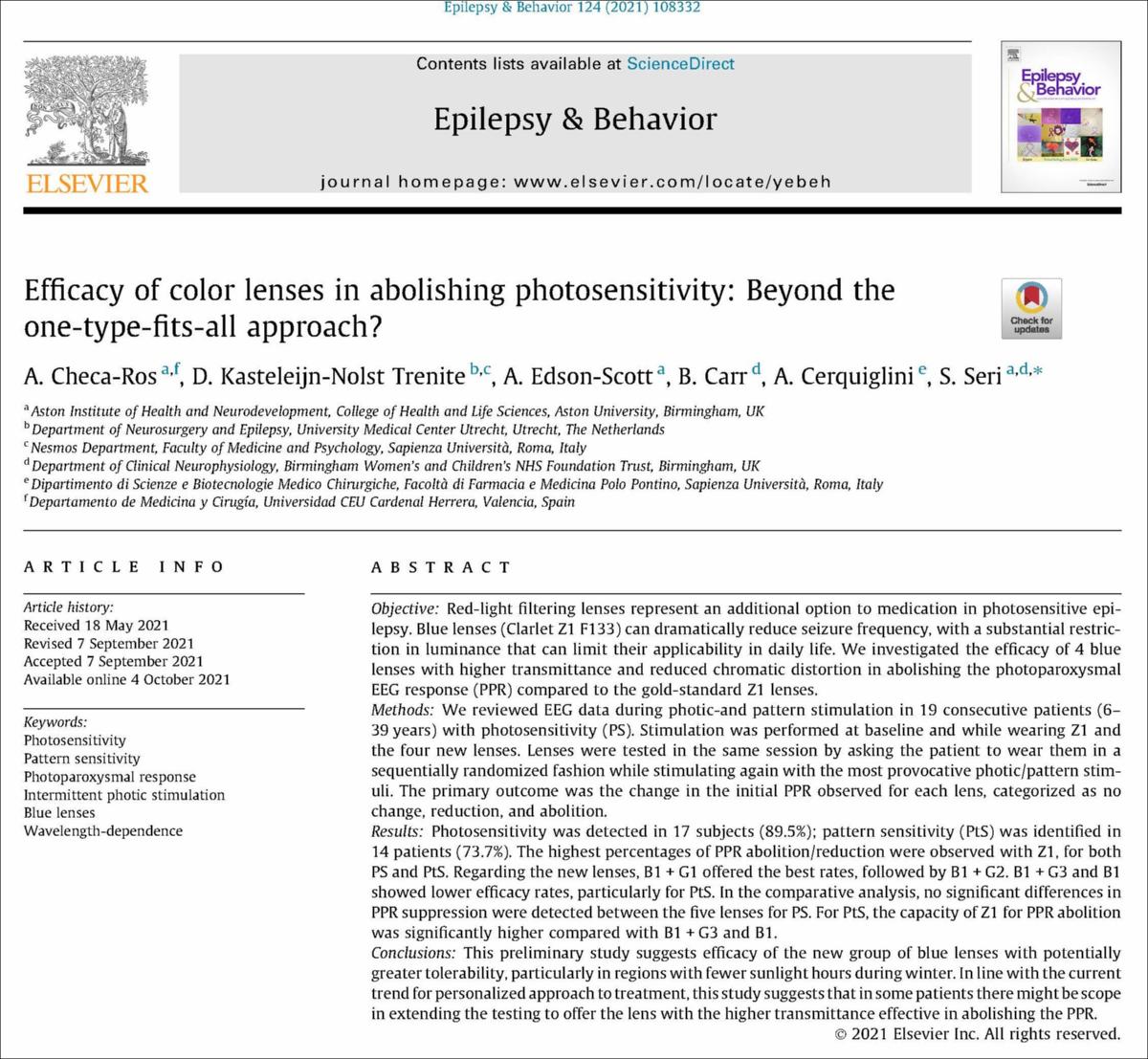Por favor, use este identificador para citar o enlazar este ítem:
http://hdl.handle.net/10637/16190Efficacy of color lenses in abolishing photosensitivity: beyond the one-type-fits-all approach?

Ver/Abrir:
Efficacy_Checa_EB_2021.jpg
1,15 MB
JPEG
Ver/Abrir:
Efficacy_Checa_EB_2021.pdf
Acceso restringido
489,45 kB
Adobe PDF
Request a copy
| Título : | Efficacy of color lenses in abolishing photosensitivity: beyond the one-type-fits-all approach? |
| Autor : | Checa Ros, Ana Kasteleijn-Nolst Trenite, D. Edson-Scott, A. Carr, B. Cerquiglini, A. Seri, S. |
| Materias: | Instrumento óptico; Optical instruments; Luz; Light; Óptica; Optics |
| Editorial : | Elsevier |
| Citación : | Checa-Ros, A., Kasteleijn-Nolst Trenite, D., Edson-Scott, A., Carr, B., Cerquiglini, A. & Seri, S. (2021). Efficacy of color lenses in abolishing photosensitivity: beyond the one-type-fits-all approach?. Epilepsy & Behavior, vol. 124 (nov.), art. 108332. DOI: https://doi.org/10.1016/j.yebeh.2021.108332 |
| Resumen : | Objective: Red-light filtering lenses represent an additional option to medication in photosensitive epilepsy. Blue lenses (Clarlet Z1 F133) can dramatically reduce seizure frequency, with a substantial restriction in luminance that can limit their applicability in daily life. We investigated the efficacy of 4 blue lenses with higher transmittance and reduced chromatic distortion in abolishing the photoparoxysmal EEG response (PPR) compared to the gold-standard Z1 lenses. Methods: We reviewed EEG data during photic-and pattern stimulation in 19 consecutive patients (6– 39 years) with photosensitivity (PS). Stimulation was performed at baseline and while wearing Z1 and the four new lenses. Lenses were tested in the same session by asking the patient to wear them in a sequentially randomized fashion while stimulating again with the most provocative photic/pattern stimuli. The primary outcome was the change in the initial PPR observed for each lens, categorized as no change, reduction, and abolition. Results: Photosensitivity was detected in 17 subjects (89.5%); pattern sensitivity (PtS) was identified in 14 patients (73.7%). The highest percentages of PPR abolition/reduction were observed with Z1, for both PS and PtS. Regarding the new lenses, B1 + G1 offered the best rates, followed by B1 + G2. B1 + G3 and B1 showed lower efficacy rates, particularly for PtS. In the comparative analysis, no significant differences in PPR suppression were detected between the five lenses for PS. For PtS, the capacity of Z1 for PPR abolition was significantly higher compared with B1 + G3 and B1. Conclusions: This preliminary study suggests efficacy of the new group of blue lenses with potentially greater tolerability, particularly in regions with fewer sunlight hours during winter. In linewith the current trend for personalized approach to treatment, this study suggests that insomepatients there might be scope in extending the testing to offer the lens with the higher transmittance effective in abolishing the PPR. |
| Descripción : | Este recurso no está disponible en acceso abierto por política de la editorial. |
| URI : | http://hdl.handle.net/10637/16190 |
| Derechos: | http://creativecommons.org/licenses/by-nc-nd/4.0/deed.es |
| ISSN : | 1525-5050 1525-5069 (Electrónico) |
| Fecha de publicación : | nov-2021 |
| Centro : | Universidad Cardenal Herrera-CEU |
| Aparece en las colecciones: | Dpto. Medicina y Cirugía |
Los ítems de DSpace están protegidos por copyright, con todos los derechos reservados, a menos que se indique lo contrario.

